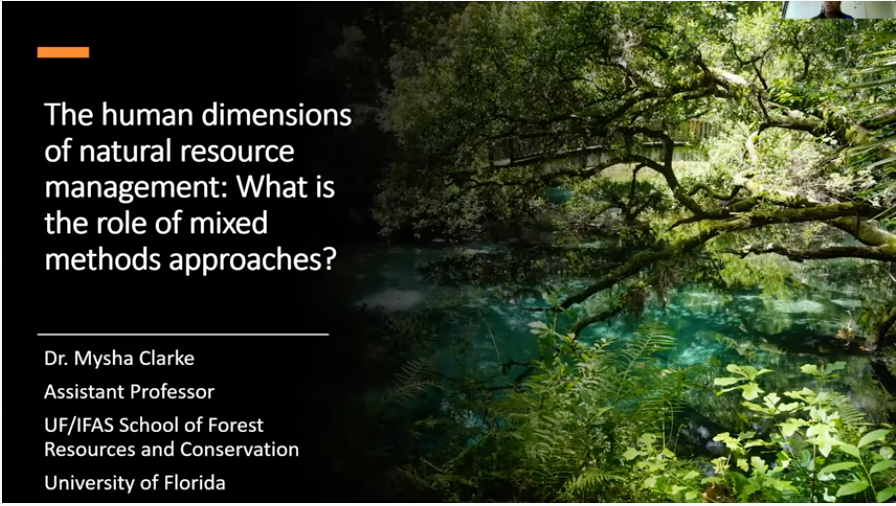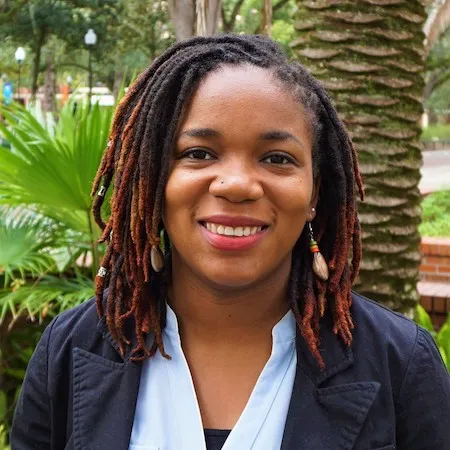This fall, SESYNC’s traditionally in-person seminars have moved to the virtual stage, providing an opportunity for participants from around the world to join us for an exciting series of lectures and Q&As with scholars tackling a breadth of socio-environmental (S-E) challenges.
Our first speaker in SESYNC’s fall seminar series was Dr. Mysha Clarke, Assistant Professor of Human Dimensions of Natural Resources, in the School of Forestry and Natural Resources at the University of Florida. Her seminar “The Human Dimensions of Natural Resource Management: What Is the Role of Mixed Methods Approaches?” provided a comprehensive look at how researchers can combine quantitative and qualitative social science research methods, also known as the mixed methods approach, to address complex S-E problems.
What Is Mixed Methods Research?
Mixed methods research integrates quantitative methods (a structured numerical assessment analyzed by mathematical methods) and qualitative methods (non-numerical data collection including interviews, text analysis, and observations to understand the meanings participants assign to an issue in depth) to address the same or related research questions or hypotheses.
Dr. Clarke spoke to the advantages of using this approach as it enhances a researcher’s ability to “triangulate the data” through different methods when trying to answer a question, which can enhance the potential validity of their findings. Mixed methods can be particularly useful when addressing multidimensional S-E problems with complex interrelated feedbacks and processes, such as the human dimensions of natural resource conservation. Dr. Clarke’s research has utilized this approach to study issues such as invasive plant management on family forestlands in Indiana—a collaborative project with Dr. Zhao Ma from Purdue University and Drs. Kristin Floress and Stephanie Snyder at the U.S. Forest Service Northern Research Station.

Mixed Methods Research Designs
Dr. Clarke outlined three core mixed methods designs that detail the process for researchers to integrate quantitative and qualitative data when developing their research project, along with examples of research articles that used each method.
- Convergent Mixed Methods Design combines quantitative and qualitative data collection to study similar or related concepts, theories, or variables. The data are then compared via a side-by-side comparison, data transformation, or joint display of data.
Example: “Views from the Field: Conservation Educators’ and Practitioners’ Perceptions of Education as a Strategy for Achieving Conservation Outcomes”: doi.org/10.1080/00958964.2012.700963
- Explanatory Sequential Design uses quantitative data collection as the first means of data collection and analysis to define the parameters around which a researcher can then implement the qualitative data phase. The qualitative data is normally used to explain or validate the quantitative data.
Example: “Implementing Integration in an Explanatory Sequential Mixed Methods Study of Belief Bias About Climate Change with High School Students”: doi.org/10.1177/1558689818762576
- Exploratory Sequential Design uses qualitative data analysis as a foundation to design the following quantitative data study.
Examples:
Qualitative data: “Insights into Individual and Cooperative Invasive Plant Management on Family Forestlands” doi.org/10.1016/j.landusepol.2018.02.010
Quantitative survey instrument article: “What are family forest owners thinking and doing about invasive plants?” doi.org/10.1016/j.landurbplan.2018.10.02
These three designs have been adapted from the book:
Creswell, John W., and J. David Creswell. Research Design: Qualitative, Quantitative, and Mixed Methods Approaches. Sage Publications, Inc., 2018.
Using Mixed Methods Approaches
There are a host of opportunities and challenges associated with using mixed methods research approaches. It can be an asset to a research project, as Dr. Clarke explains, because by using multiple methods to inform the same question, researchers can improve measurement validity while also enhancing study generalizability and casual validity in their study. This approach can be a very powerful tool for capturing the multifaceted interactions across S-E systems and validating reasoning through diverse sets of data across one problem. However, one must also consider the potential roadblocks to using a mixed methods approach. This approach can be time-consuming and will require either developing skills in quantitative and qualitative methods or sourcing them out. There are also some disciplines that continue to undervalue the validity of qualitative data approaches—despite researchers’ rigorous analysis of datasets—and the value it brings to complex research questions.
Throughout the scientific community, mixed methods approaches are growing in popularity as research becomes more interdisciplinary and scholars focus on developing a comprehensive understanding of the systems in which they are working. If you’re interested in learning more about using mixed methods approaches in socio-environmental research, please watch Dr. Mysha Clarke’s seminar.
Next Up...
Want to learn more about S-E research and be part of the SESYNC community? Join us for our fall seminar series, held biweekly on Tuesdays at 11 a.m. ET. Registration is required for all SESYNC seminars. Visit our Virtual Seminar Series page to register and learn more about our upcoming speakers.
